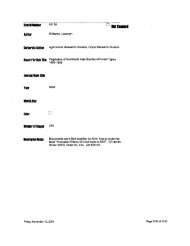Chapter 2: The Military Use of Herbicides in Vietnam - Special ...
Chapter 2: The Military Use of Herbicides in Vietnam - Special ...
Chapter 2: The Military Use of Herbicides in Vietnam - Special ...
Create successful ePaper yourself
Turn your PDF publications into a flip-book with our unique Google optimized e-Paper software.
<strong>in</strong>volv<strong>in</strong>g Blue and White. A mixture <strong>of</strong> these two herbicides resulted <strong>in</strong><br />
the formation <strong>of</strong> a precipitate consist<strong>in</strong>g <strong>of</strong> the sodium salt <strong>of</strong> 2,4-D.<br />
14. Most <strong>of</strong> the personnel <strong>in</strong>volved <strong>in</strong> the actual handl<strong>in</strong>g <strong>of</strong> the<br />
herbicide drums were <strong>Vietnam</strong>ese. However, a USAF flight mechanic or crew<br />
chief was responsible for <strong>in</strong>sur<strong>in</strong>g that the aircraft was properly loaded<br />
and the spray system functional. A flight mechanic was also the console<br />
operator for the spray unit. <strong>The</strong> pilot and co-pilot were <strong>of</strong>ficers while<br />
the flight mechanics, crew chiefs and other ground support personnel were<br />
enlisted men.<br />
15. For record keep<strong>in</strong>g purposes a herbicide "mission" consisted<br />
<strong>of</strong> several aircraft; if only one aircraft was used the operation was termed<br />
a sortie. All missions with<strong>in</strong> a target formed a project.<br />
16. Aircraft take<strong>of</strong>fs were normally before sunrise. From a<br />
tactical po<strong>in</strong>t <strong>of</strong> view, the arrival <strong>of</strong> the aircraft at the target area just<br />
prior to sunrise permitted the aircraft to approach the target from the<br />
direction <strong>of</strong> the ris<strong>in</strong>g sun. This afforded some degree <strong>of</strong> protection from<br />
enemy ground fire. From the standpo<strong>in</strong>t <strong>of</strong> herbicidal action, application<br />
by aerial spray was most effective if accomplished prior to 0800 hours<br />
while <strong>in</strong>version conditions existed, <strong>in</strong> the absence <strong>of</strong> precipitation, and<br />
while the w<strong>in</strong>d was calm or not exceed<strong>in</strong>g a velocity <strong>of</strong> 8 knots. This<br />
<strong>in</strong>sured the proper settl<strong>in</strong>g <strong>of</strong> the spray on the target area.<br />
17. With<strong>in</strong> the aircrafts, it was not uncommon to have herbicide<br />
leakage from around the numerous hose connections jo<strong>in</strong><strong>in</strong>g the spray tank<br />
and pumps with the w<strong>in</strong>g and aft spray booms. In hot weather, the odor <strong>of</strong><br />
herbicide with<strong>in</strong> the aircraft was decidedly noticeable. Periodically, the<br />
spray tank and console were removed (especially with the portable A/A 45Y-1<br />
system) and the <strong>in</strong>terior flushed with surfactant or soap and with water.<br />
Because <strong>of</strong> the corrosive nature <strong>of</strong> some herbicides, it was necessary for<br />
the aircraft to also be repa<strong>in</strong>ted periodically.<br />
18. In the 1966 through 1968 period, more than one sortie per<br />
day was <strong>of</strong>ten co'mmon. For example, dur<strong>in</strong>g the first six months <strong>of</strong> 1968,<br />
13
















